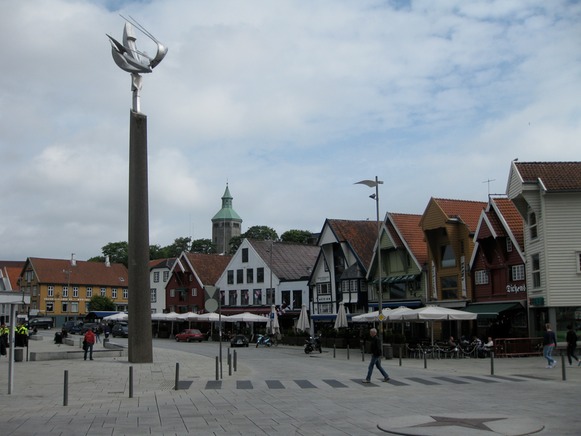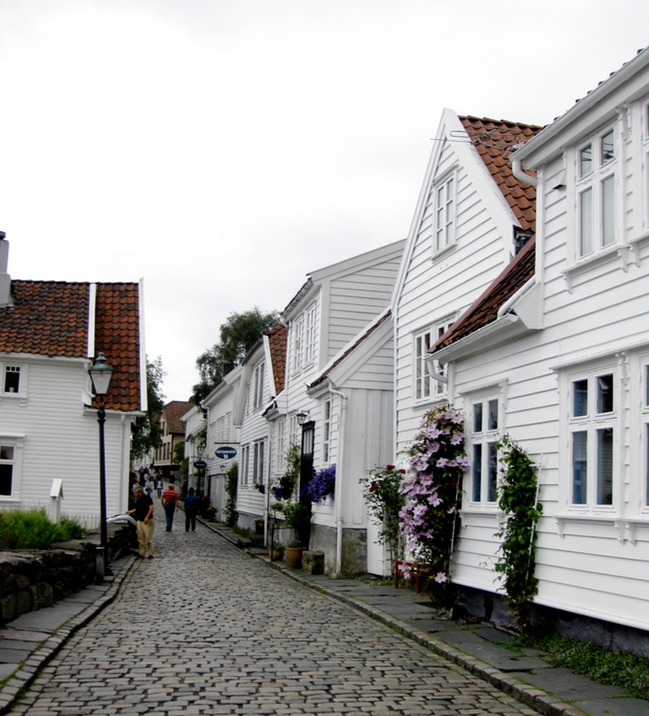We moved on to Stavanger, a relatively easy 109 miles on the E39. But this main road ends too at the water’s edge. We had two ferry rides. Because this is a main road the ferries are very frequent: we had to wait about 15 minutes for one and drove right on to the second. When we were still a mile from the boat landing, we knew the ferry had just come in because car after car after motorhome after big truck kept coming toward us on the highway.
These ferries were just as fast and efficient as the ones before--and at a similar cost ($91 for one, $86 for the other). But we pay the price because there is simply no way to get down the west coast of Norway without using ferries.
Our campground in Stavanger was located close to the city center on a small lake. We easily biked into the city twice. The campground is a sloping field with quite a few trees and very few electrical posts, each one with half a dozen outlets. There were no clearly defined spots for RVs--people just parked anywhere they wanted--so when we told the woman in the office that we would like electricity, she told us to go see if any outlets were free. It was very different from a British campground, where every “pitch” would be laid out with geometrical precision and the office would assign campers to particular slots.
We did find some free electrical outlets, but it was difficult to find a place to park without being right on top of someone else (which is frowned upon). We parked just off a paved path and strung out our electrical cable a long, long way. It has rained several times since we arrived, and some of the campground has turned into a swamp, reducing the available parking places. We are amazed at the number of RVers who continue to come in late at night. We like to arrive plenty early to increase out chances of finding a spot open. (Also, we’re not on a tight schedule, so we can afford to quit driving early if we want to.)
We really enjoyed Stavanger. The central city, smaller than Bergen, is easily walkable. We toured five different museums, among them a surprisingly interesting cannery museum. Canning sardines played a big role in the growth of this city. Today, though, it is the new oil industry. So we also toured the oil museum, detailing Norway’s newfound wealth in the North Sea. All of this history has occurred since l969. Both museums were very well done.
We also attended a wedding at the cathedral, completely by accident of timing. There were 21 people in the pews, and it was obvious that some of the others were also tourists. A beautiful bride in a lovely white gown and practically nobody there--it was kind of sad.
Like many other Norwegian towns, this one burned down somewhere in its past. The old warehouses on the wharf that have survived are now restaurants and museums.

And one old section of historic small white wooden houses, some with lovely little gardens, still stands above the harbor. A young man was washing his little house and Susan had the nerve to ask him what a house like his might be worth--maybe 20’ x 20’ story and a half--and he said over $500,000. “Many people like to live here,” he said. It was a truly quaint street, like a movie set: not big enough for cars.

Like every other city we’ve been to in Norway, Stavanger’s businesses, except for restaurants, closed up at 4 pm, in spite of the fact that the streets were still full of tourists. And on Sunday, only the restaurants and some of the museums were open.
We walked the streets and visited shops and--the high point--we bought coffee from a real coffee shop. Our Starbucks had ran out long ago, and we had been unable to find good coffee at grocery stores. So when we came upon this shop, we asked for a dark roast, ground for a french press, and indicated the size of bag we wanted. When we got back to Rover, we figured out we had just paid about $25 for a pound of coffee.
We roughly added up our expenses for the month of June and found we are spending money at quite an alarming rate, compared to our trips in previous years. Campgrounds are regularly $45 and up by the time pay extra for electricity and showers and usually wifi, and if we eat out we are spending $70 or $80. We don’t do McDonalds--which are here, along with Burger King--but we don’t eat at the most expensive places, either. Our costs are mainly food, campgrounds, gas and museums, so it’s kind of hard to find a place to cut back.
